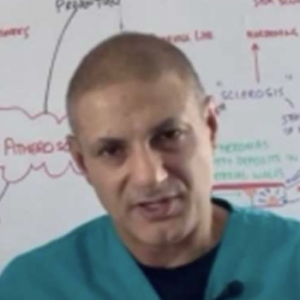Your hair is absolutely amazing, and it’s only natural to want to keep it healthy and vibrant. But before we get stuck into the science of hair, let me provide you with a summary so you know what to expect from this blog.
Table of contents
- What are the functions of hair?
- The number of hair follicles on the body
- What are the hair shaft and the hair root?
- What is the pilosebaceous unit?
- What is the structure of hair?
- What is the structure of the hair shaft?
- What is the structure of the hair follicle?
- What is the outer root sheath of the hair follicle?
- What is the inner root sheath of the hair follicle?
- What is the hair bulb?
- The nerve and blood supply to the hair follicle
- The different types of hair on the body
- What is the pilosebaceous duct?
- The two types of pilosebaceous units (PSUs)
- What are terminal hair and vellus hair?
- What is hair made of, and how does it grow?
- Summary
What are the functions of hair?
Hair is not just a leftover feature from our early human ancestors, who had to be incredibly hairy to survive without central heating. It actually serves some important functions, such as:
- Regulating our body temperature [1}
- Providing protection against friction and UV radiation [2}
- Acting as a sensory organ for tactile sensation [3]
- Playing a role in our overall sense of attraction (I don’t think we need an academic reference for this one!)
The number of hair follicles on the body
I bet you didn’t know how hairy you actually are. Go on and have a guess: how many hair follicles do you think you have on your body? The answer is about 5 million hair follicles [4] covering most of our bodies, except on the lips, palms, soles of the feet, and genital mucous membranes [5}.
These follicles start developing during the early fetal stage, and by the time we are born, we already have around 5 million hair follicles on our body. While the number of follicles doesn’t increase in our lifetime, they spread out as our body grows. For instance, the scalp has more closely spaced follicles than other body areas due to the limited head expansion.
What are the hair shaft and the hair root?
Each hair has two main parts: the hair shaft and the hair root. The shaft is the part you can see that sticks out of the skin, while the root is beneath the skin and goes down into deeper layers. The hair root is surrounded by a hair follicle, which is like a protective covering made of skin and tissue, and it’s also connected to a sebaceous gland (which produces oil).
Each hair follicle has a tiny muscle called the arrector pili that can make your hair stand up, like when you get goosebumps. There are also a lot of nerves around the follicle that detect even the slightest hair movement, so they’re very sensitive to things like drafts or light touches.
At the base of the hair root, there’s a wider part called the hair bulb. Inside the bulb is the hair papilla, which supplies the root with blood. New hair cells are constantly being made in the hair bulb, close to the papilla, allowing your hair to grow [7].
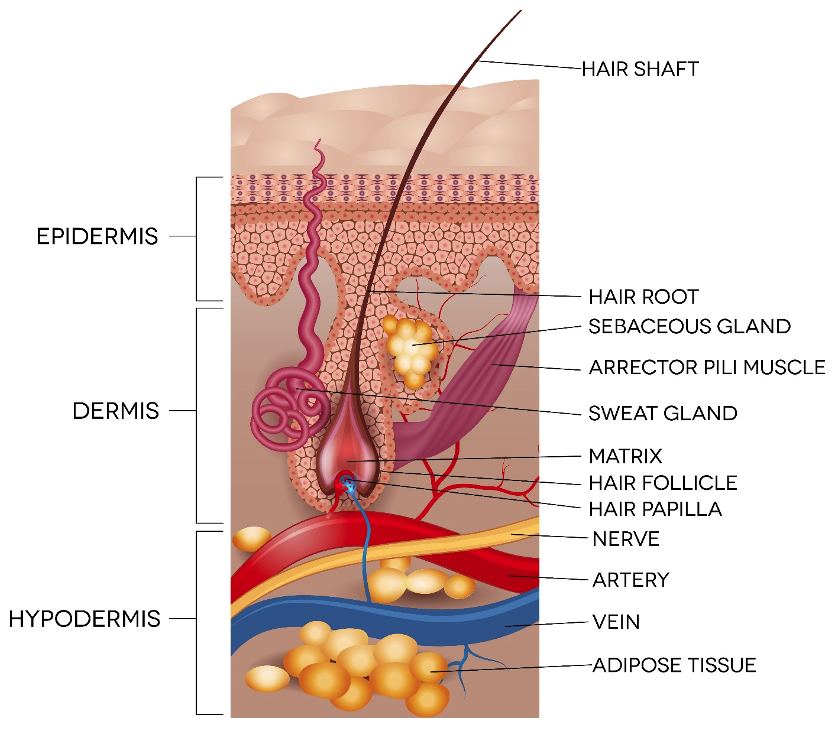
What is the pilosebaceous unit?
So, we have learnt that each hair follicle has its own muscle (arrector pili) and its own sebaceous gland. Scientists, for once, have decided to make life a little easier for us mere mortals by combining all these three units into a mini organ and giving it a name. You guessed it: they called it the pilosebaceous unit (PSU) [8].
The PSU gets its nutrients through individual blood vessels and is also connected to the sensory and autonomic nervous systems. When hairs are moved or pulled, they transmit tactile sensations, thus playing a role as sensory organs [3].
What is the structure of hair?
We have learned that hair is composed of two main parts. The first is the hair shaft, visible outside the skin, and the second is the hair follicle, located under the skin. The follicle also has two layers, called the inner and outer root sheaths; we will look into these two sheath layers in more detail below.
Did you know that hair is made up of the living dead? No, I don’t mean that you have zombies sprouting from your scalp, but rather that your hair comprises both living and non-living components. The part above the skin, the hair shaft, is made of non-living cells and is a thin, flexible structure. Below the skin, the hair is part of the living follicle, which widens at the base to form the hair bulb.
What is the structure of the hair shaft?
The hair shaft has three layers: the cortex, surrounded by cuticle cells, and sometimes a central medulla, found in thicker hair. Most of the hair’s strength, texture, and colour come from the cortex. The shaft is made chiefly of rods called macrofibrils, which are bundles of smaller fibres called microfibrils.
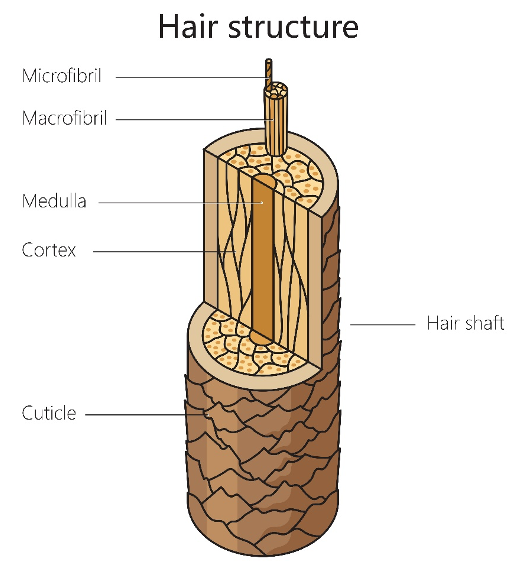
What is the structure of the hair follicle?
The hair follicle is where hair growth starts, and believe me, you miss them when they are gone. It has two main layers: the outer root sheath (ORS) and the inner root sheath (IRS).
What is the outer root sheath of the hair follicle?
The outer root sheath (ORS) in the hair follicle plays several important roles:
- Structural Support: The ORS surrounds the inner layers of the hair follicle and provides structural support to the follicle, helping to anchor the hair shaft in place as it grows.
- Stem Cell Reservoir: The ORS contains a population of stem cells located in a region known as the “bulge.” These stem cells are essential for hair growth and regeneration. They can differentiate into various cell types, including keratinocytes (which form the hair) and melanocytes (which give hair its colour). These stem cells also contribute to the repair and regeneration of the skin, and they are located in the bulge between the arrector pili muscle (the muscle that makes your hair stand up) and the sebaceous gland (which produces oil for your hair).
- Protection: The ORS acts as a protective barrier, shielding the inner part of the hair follicle from damage and helping to maintain its health during hair growth.
- Growth Regulation: The ORS interacts with other parts of the hair follicle to regulate hair growth cycles, including the growth phase (anagen), transition phase (catagen), and resting phase (telogen). We will discuss the growth cycles of hair in upcoming blog articles.
In summary, the outer root sheath is crucial for supporting hair growth, protecting the follicle, and housing stem cells necessary for both hair regeneration and skin repair.
What is the inner root sheath of the hair follicle?
The inner root sheath (IRS) in the hair follicle has several important functions related to the development and support of the growing hair shaft:
- Guiding Hair Growth: The IRS plays a key role in shaping and guiding hair as it grows out of the follicle. It helps align the hair shaft so that it grows straight up through the skin and not downward into the body.
- Supporting the Hair Shaft: The IRS surrounds and supports the hair shaft during its early stages of growth, keeping it securely attached to the follicle until it reaches the skin’s surface.
- Keratin Production: Cells in the IRS produce keratin, a protein that helps harden and strengthen the growing hair shaft. The IRS works with other layers to ensure the hair forms properly and maintains its structural integrity.
- Layers of the IRS:
- The Henle’s layer: The outermost layer of the IRS.
- The Huxley’s layer: The middle layer produces keratin and supports the hair shaft.
- The cuticle of the IRS: This innermost layer interlocks with the hair shaft’s cuticle, helping to hold the hair in place within the follicle. The cuticle is essential for giving hair a smooth, untangled appearance.
- Breaking Down: As the hair grows toward the skin’s surface, the IRS gradually breaks down and disintegrates, allowing the hair shaft to emerge from the follicle.
In summary, the inner root sheath is essential for supporting, guiding, and protecting the hair as it grows, ensuring it develops properly until it exits the skin.
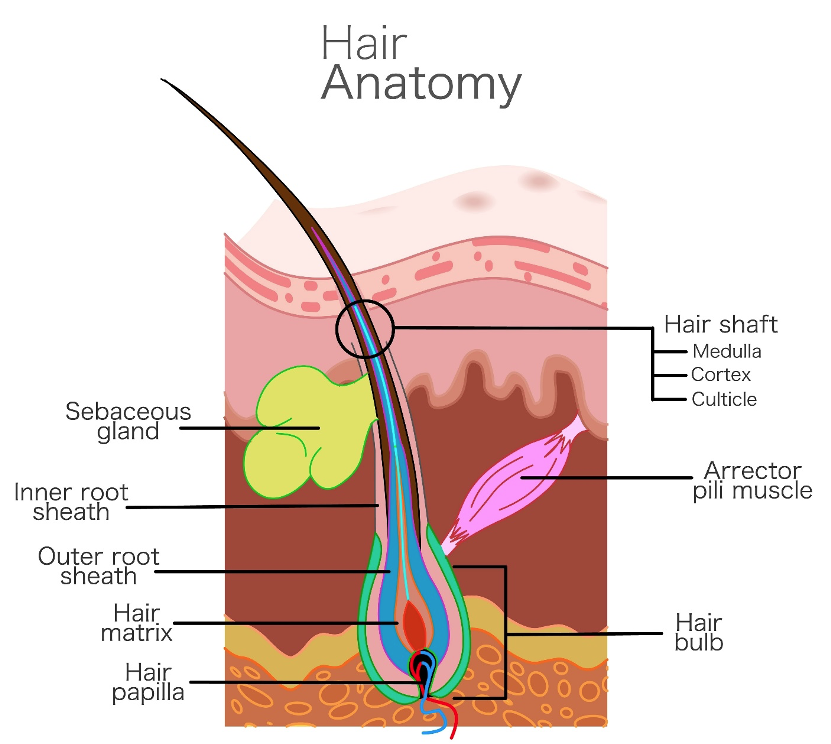
What is the hair bulb?
The hair bulb is at the bottom of the follicle, where new hair cells are made. The bulb surrounds a structure called the dermal papilla, which provides nutrients to the hair and controls its growth. The dermal papilla sends signals with special growth factors to decide each hair’s size, shape, and colour.
The nerve and blood supply to the hair follicle
The nerves that reach the hair follicle help sense touch, and tiny muscles (called arrector pili muscles) can make the hair stand up, like when you get goosebumps. This muscle contraction was useful for animals with fur, as it helped trap warmth or made them look bigger to scare off predators. While in humans, since we have invented clothes and central heating, we get goosebumps when we watch a scary film. To learn more about goosebumps, look out for our upcoming blogs.
Blood vessels near the follicle bring oxygen and nutrients to the hair to keep it growing. Hair loss in certain areas, like the legs, can sometimes signal problems with blood flow, like peripheral artery disease. While in male pattern baldness, one of the reasons postulated for the success of the vasodilator minoxidil is its ability to increase blood flow to the follicles. So, it’s not just vampires that thirst for blood; it’s your hair follicles, too.
The different types of hair on the body
There are different types of hair on the body. Terminal hair is thicker and darker, while vellus hair is much finer and shorter, making certain areas look hairless. Babies are often born with soft lanugo hair that sheds shortly after birth. Finally, club hair is fully formed hair that is ready to fall out during the resting phase of the hair growth cycle.
The only parts of the body that are truly hairless are the palms of the hands, soles of the feet, lips, and certain other small areas like the labia minora and the glans penis. There is an urban myth that masturbating is the cause of hairy palms. However, science has debunked this myth and has identified a rare genetic disorder known as circumscribed hairy dysembryoplasia of the palms, which can lead to hair growth on both palms. A dominant gene causes this inherited condition and is extremely rare, with only a few cases documented in medical literature.
In a 1975 study, researchers detailed a case involving four generations of a French-Canadian family who had small patches of skin with hair follicles near their wrists. According to the researchers, only one other scientific study had previously documented a similar condition. If the urban myth were true, then you certainly would expect more hairy hands.
What is the pilosebaceous duct?
The hair shaft is located in the pilosebaceous duct, formed by the papilla at its base. The duct also serves as an outlet for the sebum from the sebaceous gland. The hair shaft acts like a wick, helping the sebum reach the surface, keeping the skin moisturised, and providing terminal hair with a protective and water-repellent coat.
The two types of pilosebaceous units (PSUs)
There are two main types of pilosebaceous units (PSUs): those with long ducts that produce long hairs (terminal) and those with short ducts that produce very fine, lightly pigmented or non-pigmented hairs (vellus), sometimes called peach fuzz, because well it resembles peach fuzz.
What are terminal hair and vellus hair?
Terminal hairs are mainly found on the scalp and in adults, the armpits and genital area. Vellus hair follicles cover the rest of the body. During hormonal changes such as puberty, vellus hair follicles can turn into terminal hair follicles and vice versa. An example is genital hair, which starts as fine vellus hair in young children and develops into longer and thicker hair with the onset of puberty. Around 30% of the body’s skin surface in women is covered in terminal hair, compared to about 90% in men.
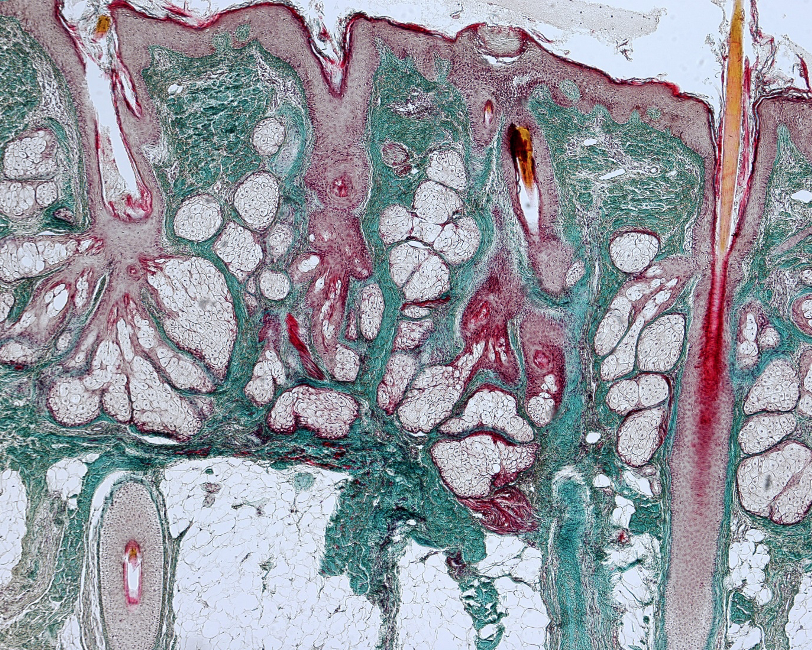
Section of scalp hairy skin showing several hair follicles with their associated sebaceous glands (pilosebaceous units) located in the dermis. Low magnification micrograph with a Masson stain.
What is hair made of, and how does it grow?
The main substance that eventually forms the hair shaft is called keratin, which is a type of protein that consists of several amino acids, in particular, alanine, leucine, arginine, and cysteine. Keratin is produced in the hair bulb, specifically by something called the follicular matrix, which sits at the base of the follicle near the papilla. New keratin cells are constantly made in the matrix, and these cells stick together and harden. As more and more cells become attached to the bottom, the hair shaft is pushed to the top and eventually reaches the outside of the skin’s surface.
The individual hair shaft consists of an inner core called the medulla, a middle layer called the cortex and an outer layer called the cuticle. The cortex is the thickest layer of the hair shaft and contains most of the hardened keratin and hair pigment. The outer cuticle layer consists of keratin cells stacked on top of each other like scales. It is covered in a thin layer of water-repellent fats derived from the sebum.
New cells are constantly being made in the hair bulb. These cells stick together and harden, and this group of hardened cells forms the entire strand of hair. As new hardened cells keep attaching to the bottom of the hair, they slowly push the hair up through the skin. This is how your hair grows, usually about 1 cm per month for hair on your head. Hair on your face, like eyelashes and eyebrows, and body hair grows more slowly.
Summary
We hope that you found this blog useful so that you can make more sense of the persuasive marketing for hair care products. Hopefully, this will allow you to identify any snake oil salesman peddling cures for anything from grey hairs to baldness. At medicalmojo.co.uk we aim to help you get the necessary knowledge to allow you to make the right decisions about your health. If you feel we have done a good job, let us know, and if you have any questions or suggestions for future articles, drop us a line.
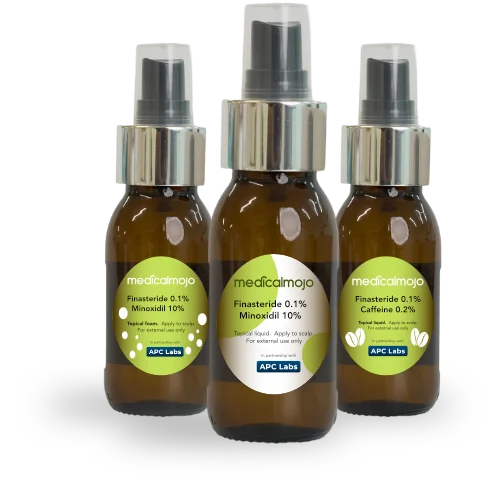
References:
- Chaplin, G., Jablonski, N.G., Sussman, R.W. and Kelley, E.A., 2013. The role of piloerection in primate thermoregulation. Folia primatologica, 85(1), pp.1-17.
- de Gálvez MV, Aguilera J, Bernabó JL, Sánchez-Roldán C, Herrera-Ceballos E. Human Hair as a Natural Sun Protection Agent: A Quantitative Study. Photochem Photobiol. 2015 Jul-Aug;91(4):966-70.
- Agramunt, J., Parke, B., Mena, S., Ubels, V., Jimenez, F., Williams, G., Rhodes, A.D., Limbu, S., Hexter, M., Knight, L. and Hashemi, P., 2023. Mechanical stimulation of human hair follicle outer root sheath cultures activates adjacent sensory neurons. Science Advances, 9(43), p.eadh3273.
- Hoover, E., Alhajj, M. and Flores, J.L., 2023. Physiology, hair. In StatPearls [Internet]. StatPearls Publishing.
- Breehl L, Caban O. StatPearls [Internet]. StatPearls Publishing; Treasure Island (FL): Mar 27, 2023. Physiology, Puberty.
- Yang FC, Zhang Y, Rheinstädter MC. The structure of people’s hair. PeerJ. 2014 Oct 14;2:e619. doi: 10.7717/peerj.619. PMID: 25332846; PMCID: PMC4201279.
- InformedHealth.org [Internet]. Cologne, Germany: Institute for Quality and Efficiency in Health Care (IQWiG); 2006-. In brief: What is the structure of hair, and how does it grow?
- Martel JL, Miao JH, Badri T, et al. Anatomy, Hair Follicle. [Updated 2024 Jun 22]. In: StatPearls [Internet].
